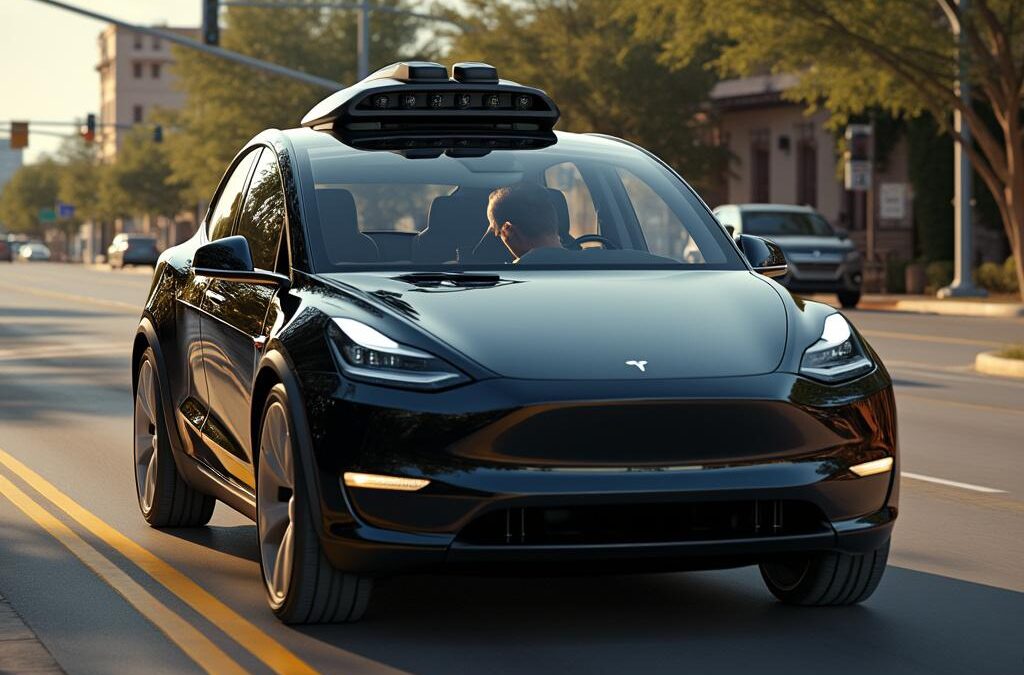Tesla Robotaxis ‘Rubberneck’ and Veer Over Yellow Lines During Launch in Austin
Tesla’s highly anticipated robotaxi service has officially launched in Austin, Texas, marking a bold step forward in the company’s autonomous vehicle ambitions. The program, which began with a fleet of approximately ten 2025 Model Y SUVs, is currently operating in a designated area of South Austin.
The service is available daily from 6:00 a.m. to 12:00 a.m., offering rides for a flat fee of $4.20. Initially, access is limited to vetted customers who received early-access invitations and downloaded Tesla’s new robotaxi app. While the vehicles are marketed as driverless, each car currently has a Tesla employee in the right front passenger seat, acting as a safety monitor.
Tesla’s approach to autonomy differs from competitors like Waymo. The company relies on a system of cameras and end-to-end AI to navigate roads, rather than lidar-based technology. This launch is part of Tesla’s broader strategy to test and refine its Full Self-Driving (FSD) technology in real-world conditions.
However, the rollout has not been without issues. Observers have reported that some robotaxis have veered over yellow lines and exhibited “rubbernecking” behavior, where the vehicles slow down or hesitate in response to certain situations. These incidents have raised questions about the safety and reliability of Tesla’s autonomous system.
Despite these challenges, Tesla is already exploring expansion opportunities. The company is in discussions with other cities, including Palo Alto, to launch similar robotaxi test programs. However, these efforts have been met with skepticism, particularly regarding regulatory hurdles and the readiness of Tesla’s FSD technology.
For now, the Austin launch serves as a proving ground for Tesla’s vision of autonomous transportation. Whether the program succeeds in addressing its current limitations will likely shape the future of robotaxi services not just for Tesla, but for the entire industry.
Read more about Tesla’s robotaxi program and its implications for autonomous transportation.
Challenges and Future Prospects of Tesla’s Robotaxi Service
While Tesla’s robotaxi service in Austin represents a significant milestone, it also faces several challenges that could impact its scalability and adoption. One major concern is the current reliance on human safety monitors. Although the vehicles are marketed as driverless, each robotaxi currently has a Tesla employee in the right front passenger seat to oversee operations and intervene if necessary. This approach, while prudent for testing purposes, adds operational costs and complicates the service’s long-term viability.
Another critical issue is the performance of Tesla’s Full Self-Driving (FSD) technology. Observers have noted instances where the robotaxis have veered over yellow lines and exhibited “rubbernecking” behavior, such as slowing down or hesitating in response to certain scenarios. These incidents, while not necessarily safety-critical, highlight the ongoing development and refinement needed for Tesla’s autonomous driving system. Critics argue that such behavior could erode public confidence in the technology, especially as competitors like Waymo have demonstrated more polished autonomous capabilities.
Tesla’s decision to use a camera-based system rather than lidar has also sparked debate. The company’s approach relies on a combination of cameras and end-to-end AI to navigate roads, a strategy that differs from other autonomous vehicle developers. While this method may reduce costs and complexity, it has yet to match the precision and reliability of lidar-based systems in real-world testing.
Despite these challenges, Tesla is actively exploring expansion opportunities. The company is reportedly in discussions with other cities, including Palo Alto, to launch similar robotaxi test programs. However, these efforts are likely to face regulatory hurdles, as many jurisdictions remain cautious about approving fully autonomous vehicles without comprehensive safety assurances. Tesla’s FSD technology, in particular, has faced scrutiny from regulators and industry experts, who question its readiness for widespread deployment.
The Austin launch serves as a critical testing ground for Tesla’s autonomous ambitions. The company’s ability to address the current limitations of its robotaxi service will not only determine the success of its own program but also influence the broader autonomous vehicle industry. As Tesla continues to refine its technology and expand its operations, the outcomes in Austin will be closely watched by regulators, competitors, and consumers alike.
Conclusion
Tesla’s robotaxi service in Austin marks a pivotal moment in the evolution of autonomous transportation. Despite its promising start, the program faces notable challenges, including the reliance on human safety monitors, the performance of its Full Self-Driving (FSD) technology, and regulatory uncertainties. The service’s current limitations, such as veering over yellow lines and “rubbernecking” behavior, underscore the need for continued refinement. However, Tesla’s camera-based approach and aggressive expansion plans demonstrate its commitment to advancing autonomous driving. The success of this initiative in Austin will not only shape Tesla’s future but also influence the broader autonomous vehicle industry.
Frequently Asked Questions
-
What is Tesla’s robotaxi service?
Tesla’s robotaxi service is an autonomous ride-hailing program currently operating in Austin, Texas, using a fleet of 2025 Model Y SUVs equipped with Full Self-Driving (FSD) technology. -
Where is Tesla’s robotaxi service available?
The service is currently available in a designated area of South Austin, with plans for potential expansion to other cities like Palo Alto. -
How much does Tesla’s robotaxi service cost?
The service is priced at a flat fee of $4.20 per ride. -
Is Tesla’s robotaxi service fully autonomous?
While the vehicles are marketed as driverless, each robotaxi currently has a Tesla employee in the right front passenger seat to act as a safety monitor. -
What challenges has Tesla’s robotaxi service faced?
The service has experienced issues such as veering over yellow lines and “rubbernecking” behavior, raising concerns about the reliability of its FSD technology. -
How does Tesla’s autonomous technology differ from competitors?
Tesla relies on a camera-based system and end-to-end AI, unlike competitors like Waymo, which use lidar-based technology for autonomous navigation. -
Can I access Tesla’s robotaxi service now?
Currently, access is limited to vetted customers who have received early-access invitations and have downloaded Tesla’s robotaxi app.

